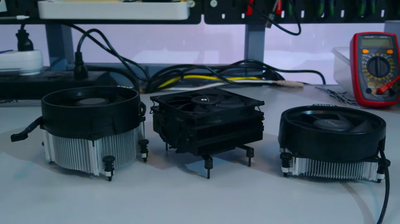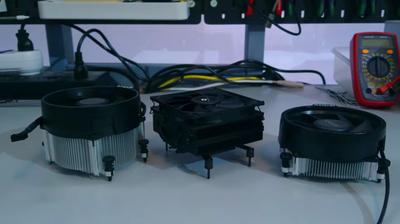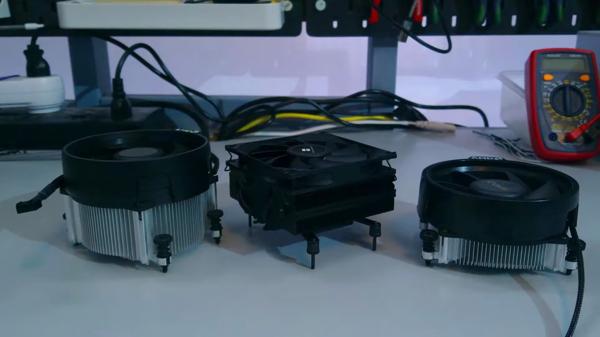
My thoughts on the Thermalright AXP90 X36 Low Profile ITX CPU Cooler (2024)
My thoughts on the Thermalright AXP90 X36: design, installation, performance, and competition.
Introduction
I recently built a small form factor PC and was looking for an efficient cooling solution. The Thermalright AXP90 X36 is a great fit for its low-profile design and promised compatibility with a range of CPUs. I appreciate a quiet and cool operation - below is my experience with it.
Some photos (click to enlarge)




Specs of the Thermalright AXP90 Low Profile Cooler
- Release Year
- Brand
- Compatible Devices
- Material
- Maximum Rotational Speed
- Noise Level
- Power Connector Type
- Product Dimensions
- Voltage
- Wattage
Prices
Design and Compatibility of Thermalright AXP90 X36

Navigating the small form factor PC build arena comes with its unique set of challenges, especially when it comes to selecting the right cooling solution. The Thermalright AXP90 X36, with its low-profile design, strikes an attractive balance between form and function. Here's a rundown from my personal experience that supports this notion:
Ultra-low height of 36mm makes it a snug fit for HTPC, ITX, and slim cases.
Broad compatibility with various Intel and AMD CPU slots ensures it's a versatile option for many builds.
Optimized heatsink design does not interfere with PCIe or RAM slots, a common issue with other coolers.
The overall build quality, including nickel-plated copper base, lends a feeling of durability and efficient heat transfer.
One of the standout features that I appreciate is the compact size of the AXP90 X36. Measuring just 94.5×95×36mm, it's clear that Thermalright designed this cooler with space-restricted builds in mind. The aluminum radiator, combined with a 92mm PWM fan, provides adequate cooling without the dreaded 'memory limitation worries' that come with larger units.
As for the AGHP technique, I'm intrigued by its promise to tackle the inverse gravity effect and improve cooling efficiency. While I haven't run any scientific tests myself, in practical use, I've seen a consistent performance that gives me confidence in its capabilities.
However, it's not without its drawbacks. While installation is straightforward, especially with an instructional video, some might find the lack of "stops" on the mounting screws somewhat concerning, as overtightening could potentially bend the motherboard. It's crucial to approach the installation process with a gentle hand and a bit of caution.
On the flip side, this cooler doesn't quite match up to the heavy-duty performance required for overclocked CPUs or high-intensity operations – it's not a one-size-fits-all solution. For instance, with my i7 9700k, I noticed marginal improvement in throttling performance compared to the stock cooler, although with quieter operation.
In terms of material construction, while aluminum is excellent for heat dissipation and keeping the weight down, it may not have the same thermal conductivity as, say, a copper-cooled equivalent, which is something to keep in mind depending on the computer's usage scenarios.
Lastly, It's apparent that this cooler hits a sweet spot for budget-conscious users who want efficient cooling in a small form factor and do not plan to push their CPUs with sustained heavy workloads. In essence, the Thermalright AXP90 X36 seems to be an ideal pick for a specific market niche—a compact, reliable cooler indispensable for the casual gamer or regular desktop user, especially when noise level and space limitation are of concern.
Installation and Setup Process

When tackling the installation and setup process of the Thermalright AXP90 X36, I appreciated the attention to detail offered by the brand. The package comes with all the necessary mounting hardware, and considering the cooler's broad compatibility with various CPU sockets, it's a relief to find the right parts for both Intel and AMD platforms. Here's a quick rundown:
Well-labeled parts: Each piece is clearly marked, which simplifies the process.
Instruction clarity: The included manual is straightforward, but I found the online tutorial video even more helpful.
Tool-free installation: Except for a screwdriver, no additional tools are needed.
However, the ease of installation did come with a few caveats at times. The pre-installed nuts and screws on the cooler were notably snug, necessitating careful handling with pliers to adjust. Users should take note that overtightening can potentially warp your motherboard, given the absence of "stops" on the screws - a potentially crucial detail overlooked in the design.
In smaller ITX cases or cramped spaces like those found in ASRock's DeskMini series, the low-profile nature of this cooler is a godsend. Maneuvering the fan to avoid contact with RAM or neighboring motherboard components is key; a delicate 2-3mm clearance does the trick without inducing a sweat.
I did experience a hiccup with an older LGA1151 ITX motherboard, where fitting the cooler proved difficult due to interference with the surrounding mosfets. A slight design adjustment to raise the heat pipes could solve such issues for future iterations.
For those worried about potential component damage during installation, the AXP90 X36's design minimizes this risk, though the reported flimsiness of the backplate did catch my attention. While I didn't personally notice bending, the feedback on insulation quality is something I believe Thermalright could address in future models.
Overall, the installation and setup were far from daunting – it was actually quite user-friendly, particularly for folks who've dealt with CPU coolers before. For those new to the process, the abundance of user-supplied tips and tricks available online creates a communal feel to getting this cooler up and running.
But remember, in a tight space, every millimeter counts. The Thermalright AXP90 X36 impresses with its compact design and setup versatility, but keep in mind the potential for motherboard bending if you get a little too enthusiastic tightening things down.
Performance in Various Environments

When evaluating the Thermalright AXP90 X36, I've found that its performance varies quite a bit depending on the use case. Here's a quick rundown:
HTPC or ITX Builds: This cooler is at home in small cases. Its 36mm height and the ability to fit into SFF (Small Form Factor) setups without memory interference make it ideal.
Vertical versus Horizontal Orientation: Thanks to the AGHP technique, there's no significant performance drop-off when switching between orientations.
Low to Moderate Workloads: Performs admirably for general computing, media consumption, and even light gaming.
High-Performance CPUs: Struggles with high TDP processors like the i7 9700k or i9 13900kf under load.
In smaller cases like the Dell XPS or ASRock DeskMini X300M, space for heat dissipation is at a premium. The AXP90 X36's slim form factor means I can easily fit a video card or avoid crushing nearby MOFSETs on older ITX motherboards, which is a huge plus. But the trade-off is that, for high TDP CPUs, this cooler isn't quite up to the task — I've noticed temperature spikes during intense gaming sessions or heavy workloads.
However, for lower-TDP CPUs, this cooler is a champ. I've had success using it with processors like the Ryzen 5 4600G, where it managed to maintain reasonable temperatures without too much noise. It's important to note that while it claims broad compatibility, those with older motherboards should double-check the clearance around the CPU socket to avoid any fitment issues.
The construction is decent, with the nickel-plated copper base and soldered heat-pipes to fins ensuring durability and effective heat transfer. Yet, be careful during installation — it's easy to over-tighten and potentially bend your motherboard, given the lack of stops on the screws.
From a noise perspective, the TL-9015 fan stays whisper quiet, even under load, which is something I've come to appreciate in my living room HTPC setup. Power usage is also minimal at just 3.6 watts, which is barely a blip on the radar for most systems.
To sum it up, the Thermalright AXP90 X36 is a competent cooler for the right circumstances. If you're running a low to moderate TDP CPU in a compact environment and are looking for a budget-friendly, quiet cooling solution, this could be a perfect fit. Just don't expect it to keep up with the more robust cooling needs of high-end gaming rigs or workstations.
Comparative Analysis with Other Coolers

In my quest for the optimal low-profile CPU cooler, the Thermalright AXP90 X36 stands out in a crowded market. Having experimented with various competitors, including stock coolers and offerings from brands like Noctua, I find this cooler presents an interesting case, striking a balance between compact design and performance.
The main advantages of the AXP90 X36 can be summarized as follows:
Height: At 36mm, it's among the shortest coolers, perfect for slim cases.
Compatibility: It fits a wide range of CPU sockets, from Intel's LGA1700 to AMD's AM4/AM5 platforms, making it versatile.
AGHP Technique: The use of 4×6mm heat pipes and AGHP technique helps combat the inverse gravity effect, potentially doubling the cooling efficiency.
Noise Level: With a noise level of 22.4 dB, it's commendably quiet, which is appreciated in living room setups or quiet work environments.
However, it's not without its drawbacks. While it's compatible with a variety of CPU sockets, I've noted that it struggles with higher TDP processors, like the i7 9700k and the 13900kf under intense workloads, hitting high temperatures that suggest it's more suited to less demanding CPUs. There's also the matter of build quality, particularly the mounting backplate which could be more robust to prevent potential bending of the motherboard.
In comparison to other popular solutions such as the Noctua L9 series, the AXP90 X36 offers a competitive edge in pricing, and in my case, slightly better temperature performance—approximately 1 to 2C cooler. Although it grapples with high-end CPUs, for an i3 or Ryzen 3 CPUs, this cooler is more than capable. Its low-profile design also allows for more breathing room in small form factor cases, helping with overall airflow.
From a personal perspective, the Thermalright AXP90 X36 is a mixed bag. While it might fall short for power users with beefy CPUs pushing the envelope on overclocking or sustaining long periods of heavy load, it's a budget-friendly and competent option for more moderate rigs. Easy installation (assuming access to the back of the motherboard) and quiet operation are bonuses that cannot be overlooked.
Although I'd like to see improvements like a sturdier backplate and perhaps a version catered to higher TDP CPUs, the Thermalright AXP90 X36 has carved out its niche in the small form factor cooling arena by offering a reliable option for those who need a low-profile, quiet cooler without breaking the bank.
Comments (0)
Share